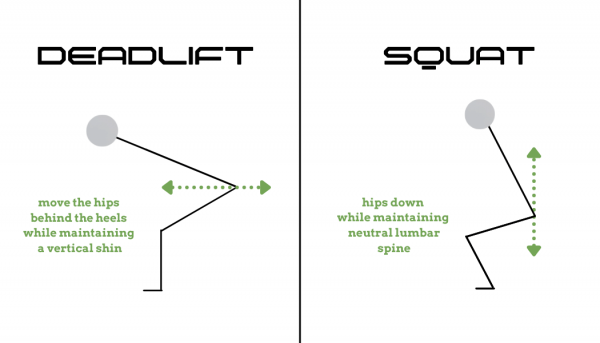When comparing squats to deadlifts, both exercises are efficient in strengthening and engaging the glutes; however, they focus on distinct muscle groups and movement techniques to varying extents.


Squats engage numerous muscles, such as the glutes, quadriceps (front thighs), and hamstrings (back of thighs). Nevertheless, research published in the European Journal of Sport Science indicates that squats predominantly target the quadriceps. Conversely, deadlifts are classified as a “hip hinge” exercise, primarily activating the glutes and hamstrings, with the glutes experiencing slightly higher engagement than squats. The debate of squat vs deadlift effectiveness is ongoing; continue reading to explore further.
Squats Exercise and Range of Benefits
Squats prove to be a highly beneficial exercise for fortifying muscles throughout the lower body, boosting fitness levels, and improving everyday and athletic performance. The exercise offers a wide array of advantages for overall health and functionality.


1. Effective Glute Activation: Squats are a great exercise for activating the glute muscles, particularly the gluteus maximus. Proper form and technique are crucial for ensuring that the glutes are engaged during the movement. This involves hinging the hips back and keeping the weight in the heels, which helps to target the glutes more effectively.
2. Glute Strength and Development: Squats are a compound exercise that works multiple muscle groups, including the glutes. By strengthening the glutes through squats, you can improve overall lower body strength and muscle mass. This is particularly important for athletes and individuals who engage in activities that require powerful leg movements.
3. Improved Posture and Balance: Strong glutes can help improve posture and balance by providing additional support for the lower back and pelvis. This is especially important for individuals who experience back pain or have a history of back injuries.
4. Enhanced Functional Movement: Squats are a functional exercise that mimics many everyday movements, such as bending and lifting. By strengthening the glutes through squats, you can improve your ability to perform these movements with greater ease and efficiency.
5. Reduced Risk of Injury: Squats can help reduce the risk of injury in the lower body by strengthening the muscles and connective tissues around the knees, ankles, and hips. This is particularly important for athletes and individuals who engage in high-impact activities.
See also How Many Pushups Do You Need to Do to See Results? — Eat This Not That
6. Improved Bone Density: Squats are a weight-bearing exercise that can help improve bone density in the lower body, particularly in the spine and hips. This is beneficial for individuals with osteoporosis or those at risk of developing the condition.
7. Enhanced Athletic Performance: Strong glutes can enhance athletic performance by providing additional power and speed. This is particularly important for sports that involve explosive movements, such as jumping and sprinting.
8. Improved Flexibility and Mobility: Squats can help improve flexibility and mobility in the hips, knees, and ankles by stretching and strengthening the surrounding muscles and connective tissues.
9. Reduced Risk of Falls: Strong glutes and legs can help reduce the risk of falls by improving balance and stability. This is particularly important for older adults who are at a higher risk of falls due to decreased muscle mass and bone density.
10. Improved Overall Fitness: Squats are a compound exercise that works for multiple muscle groups, making them an effective exercise for improving overall fitness and muscle mass. This can lead to a range of benefits, including increased metabolism, improved body composition, and enhanced athletic performance.
How to Do a Squat
To perform a squat with proper form, follow these steps:
- Stand with your feet shoulder-width apart, toes slightly pointing outwards. This positioning helps ensure your knees do not cave in during the squat.
- Engage your core muscles. Imagine bracing for a punch; feel your abs tighten. This engagement helps maintain balance and protect your lower back.
- Begin by hinging at the hips, not by bending your knees. Push your hips back as if trying to sit back into a chair. This movement initiates the descent of the squat.
- Lower your body by bending your knees and hips simultaneously. Ensure your knees remain aligned with your feet and do not extend beyond your toes. Your chest should remain upright, and your back should stay straight.
- Aim to squat down until your thighs are parallel to the ground or slightly lower. This depth ensures you’re working the targeted muscles effectively. Going too shallow can reduce the effectiveness of the exercise.
- To return to the starting position, push through your heels and engage your glutes to straighten your legs. Keep your chest up and continue to engage your core throughout the movement.
Common Mistakes to Avoid:
- Ensure your knees do not collapse inward. Your knees should track over your toes, not beyond them.
- Maintain a straight back and engaged core throughout the movement to prevent rounding.
- Remember to brace your core before beginning the squat and keep it engaged throughout the movement.
- Keep your heels on the ground the entire time. Drive down through your heels to rise back up.
See also The #1 Best Bench Press Workout To Increase Strength & Muscle
Deadlift Exercise and Range of Benefits
Deadlifts are exercises for sculpting a strong, fit body. A scientific report by Nature Journal, shows they build muscle mass and strength, improve athletic performance, and contribute to a healthier you by enhancing body composition and overall well-being. Here are the benefits of deadlifts.


1. Increase Muscle Growth: Deadlifts are known for their ability to build significant muscle mass, particularly in the posterior chain (hamstrings, glutes, and lower back). This is because they engage multiple muscle groups simultaneously, making them an effective exercise for muscle growth and strength development.
2. Improve Grip Strength: Deadlifts require a strong grip to hold onto the weight, which can improve grip strength over time. This is especially important for athletes who need to perform tasks that require manual dexterity and strength.
3. Increased Bone Density: Deadlifts can help maintain bone density by stimulating bone formation and enhancing mineral content. This is particularly beneficial for individuals at risk of osteoporosis or those aiming to maintain bone health as they age.
4. Increased Resting Metabolic Rate: Deadlifts can increase resting metabolic rate (RMR), which means that the body continues to burn more calories at rest after the exercise. This can be beneficial for those looking to improve body composition and overall health.
5. Postural Strength: Deadlifts help develop postural strength by targeting core muscles, such as the abdomen and lower back. This contributes to a stable and well-supported spine, reducing the risk of musculoskeletal issues and enhancing overall body alignment.
6. Enhance Athleticism and Performance: Deadlifts are a functional exercise that mirrors many skills required for athletic performance, such as jumping, sprinting, and quickly changing directions. This exercise can enhance overall athleticism and performance in various sports.
7. Reduce Back Pain: Deadlifts can help reduce back pain by strengthening the postural muscles needed to maintain proper posture and reduce the risk of injury. This is especially important for individuals who experience back pain or have a history of back injuries.
8. Functional Movement: Deadlifts are a functional movement that translates to everyday activities, such as lifting heavy objects or carrying groceries. This exercise helps build strength and coordination that can be applied to real-life situations.
See also The ‘Bro Split’ Workout for Bigger Muscles: Everything to Know
9. Hormonal Response: Deadlifts can stimulate a strong hormonal response, including the release of growth hormone and testosterone, which promote muscle growth, recovery, and overall well-being.
10. Possible With Different Training Tools: Deadlifts can be performed with various training tools and in different variations, making them a versatile exercise that can be tailored to individual fitness goals and needs.
How to Do a Perfect Deadlift
- Stand with the barbell over your midfoot. Your shins should be about an inch away from the bar.
- Don’t bend your back to reach the bar. Hinge at your hips and knees, keeping your back straight, and grab the bar with a shoulder-width grip. Your arms should be hanging straight down.
- Take a big breath and brace your core as if someone is about to punch you in the stomach. This will stabilize your spine.
- Think about squeezing your shoulder blades together and pushing your chest out. This will help keep your back in a neutral position.
- Now, the actual lift. Push your feet through the floor and extend your legs, straightening your back as you rise. The bar should stay close to your body throughout the movement, practically scraping your shins.
- Imagine pushing your hips forward as you extend your legs. This will help you use your glutes and hamstrings to lift the weight, not your lower back.
- Don’t just let the bar fall. Reverse the lifting motion, pushing your hips back and bending at the knees to lower the bar in a controlled manner.
- Keep the bar close to your body as you lower it throughout the entire descent.
Tips for Perfection
- It’s tempting to go heavy fast, but especially when you’re learning, focus on form with lighter weights.
- Film yourself doing a deadlift and see if your form matches the descriptions.
- A qualified coach can observe your form and provide personalized guidance to ensure you’re doing the deadlift safely and effectively.
In conclusion, squat and deadlift exercises are effective for building glute strength and size, however, deadlifts may be slightly more effective for targeting the glutes. The hip-dominant nature of the deadlift and the ability to use heavier loads compared to squats can lead to greater glute hypertrophy and strength gains.
Frequently Asked Questions (FAQs)
Squat vs Deadlift: Which one is better in terms of muscle activation for the glutes?
1. What muscles are worked in squats and deadlifts?
In both squats and deadlifts, you primarily target the glutes, hamstrings, and quadriceps. Squats also engage the core, lower back, and calves, while deadlifts work the lower back, traps, and forearms.
2. Which exercise better targets the glutes – squats or deadlifts?
While both squats and deadlifts work the glutes, the deadlift is generally considered more effective in targeting the glutes. Deadlifts place a significant emphasis on the glutes due to the hip-hinging motion involved in the exercise.
3. How can I maximize glute activation in squats and deadlifts?
To maximize glute activation in squats, focus on proper form and technique, ensuring that you engage your glutes throughout the movement. In deadlifts, emphasize pushing through your heels and squeezing your glutes at the top of the lift for optimal activation.
4. Can I include both squats and deadlifts in my workout routine for maximum glute development?
Absolutely! Incorporating both squats and deadlifts into your workout routine can help target the glutes from different angles and improve overall glute development. Be sure to balance the volume and intensity of each exercise to prevent overtraining.






